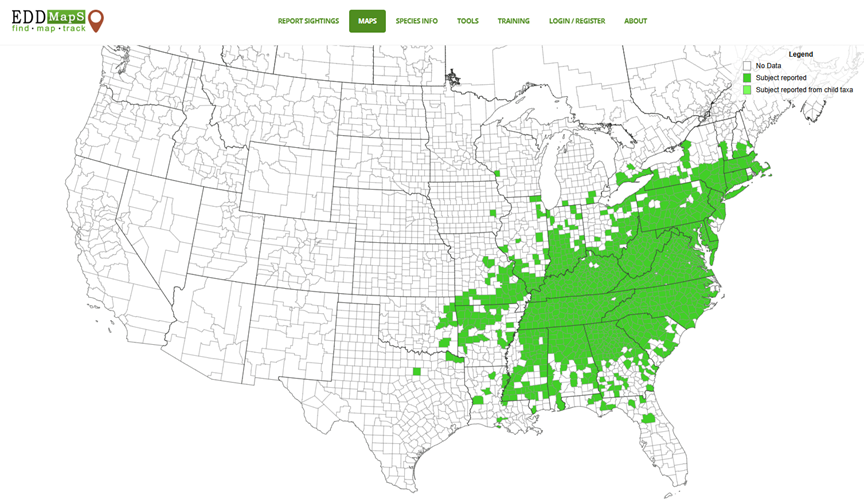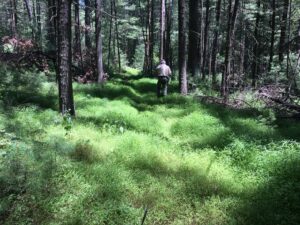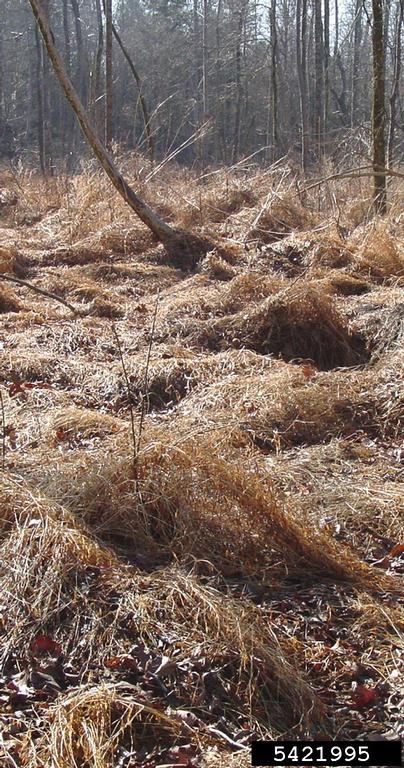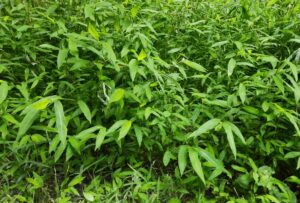
Heather N. Kolich, ANR Agent, UGA Extension Forsyth County
About this time last year, I wrote about a couple of very visible invasive plants. One was Japanese stiltgrass (Microstegium vimineum), a sun- and shade-tolerant grass that has spread so far it is known by several names, including Nepalese browntop, Asian stilt grass, and Chinese packing grass.
Japanese stiltgrass is native to Asia and is believed to have come to North America in the early 1900s in a shipment of porcelain from China. The grass was used as packing material. Using natural, biodegradable packing material seems like a great idea. Unfortunately, the grass contained viable seeds that began growing in Tennessee in 1919.

Since then, invasive Japanese stiltgrass has spread to 29 additional states, reaching as far west as Texas, north to Ontario, Canada, south to Florida, up the east coast to Vermont and New Hampshire. It’s expected to continue spreading northward to Maine and to gain a foothold in west coast states, as well.
Non-native invasive species harm local ecosystems
In natural ecosystems, a variety of plants, insects, and wildlife exist in a harmonious balance that developed over thousands of years. When non-native species enter that ecosystem, the natural competitors that keep them in check in their own environment usually aren’t present.
Many non-native plants, like wheat and apples, are useful and don’t cause environmental problems. Some non-native species, however, spread aggressively and successfully and can cause significant damage to the native ecological balance.

Kudzu is an example of a very successful non-native, invasive plant. We see it when we’re driving down almost any road outside of city limits. We’ve probably all seen, but perhaps didn’t recognize, Japanese stiltgrass growing in our parks, along roadsides, and even in our yards. It is an increasing problem, and the Georgia Forestry Commission has ranked it as the 2nd worst non-native invasive plant in Georgia forest lands. It covers forest floors, smothering native plants and changing the soil so that native plants can’t grow. It reduces nesting and foraging habitats for wildlife. When it dies in the winter, Japanese stiltgrass leaves dense thatch that presents a wildfire hazard.
Take action for our parks
When a non-native species is introduced, there is a small window of time in which early detection and action can eradicate the species and prevent it from becoming invasive. We’ve missed that window with Japanese stiltgrass, but that doesn’t mean we should give up and allow it to swallow our parks and yards. We can take action to control it, reduce its spread, and even clear it out of localized areas.
Forsyth County Extension and Parks and Recreation are partnering on a community-based Environmental Action initiative to reduce Japanese stiltgrass in our local parks. Through this family-friendly, non-chemical approach, we’re training county residents and park visitors to recognize, report, and help remove non-native, invasive Japanese stiltgrass from specific areas of Chattahoochee Pointe Park and Sawnee Mountain Preserve. Our goal is to clear Japanese stiltgrass from a total of five acres in these parks through community action during the next two years, and then continue the community initiative in other county parks and with other invasive plant species.

Why are we focusing on this particular plant? Because we have a high likelihood of success with Japanese stiltgrass removal. Unlike many other non-native invasive plants, Microstegium is an annual plant that reproduces only by seed. It spreads quickly because it can grow roots where nodes touch the ground. But the roots are shallow, so it’s easy to pull out by hand – no tools or herbicides needed. If we pull out the grasses before they flower in September, we can prevent thousands of new seeds from being deposited in the soil. Fewer seeds in the soil mean fewer Japanese stiltgrass plants next year, and that gives native plants a better chance to grow.
How to be an Environmental Action Hero
We’re offering four Environmental Action Workshops in July where you’ll learn about several invasive plants of North Georgia, how they disrupt local ecosystems, and how to use apps to report invasive species. Then we’ll take hands-on action to identify and clear Japanese stiltgrass from specific areas of the park.
These are family-friendly workshops, and we welcome groups as well. We can’t have too many Environmental Action Heroes!
Workshop details
Chattahoochee Pointe Park, July 18 & 19, 9-11 a.m. Meet at the outdoor classroom in the Sustainable Community Orchard.
Sawnee Mountain Preserve Visitor Center, July 25 & 26, 9-11 a.m. Meet outside the front entrance.